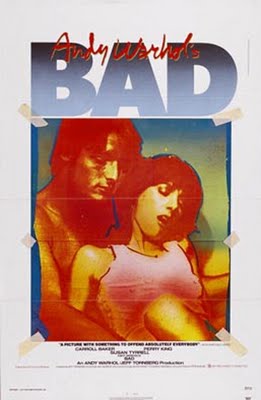
ANDY WARHOL'S BAD
US, 1976, 104 minutes, Colour.
Carroll Baker, Perry King, Matthew Anton, Cathy Roskam, Susan Tyrell.
Directed by Jed Johnson.
Andy Warhol's Bad is not a film by Warhol himself, rather it comes from his factory and was written and directed by Jed Johnson. In the '60s artist and experimenter Warhol made a number of films, focusing on the subculture in which he lived and worked and on the various personalities involved. There was a strong sexual emphasis and black and satiric humour e.g. lonesome cowboys. This was continued by Paul Morrissey but in a more structured form in such films as Heat, Flesh, Trash and the Dracula and Frankenstein films. Johnson continues in this vein with a narrative plot, the use of recognised stars as well as some from the subculture. The script is tighter and there is less improvisation. However, the tone is still satiric and very black. The film is a blend of sick and black humour and has the extraordinary power to make an audience laugh at death and murder. It does this successfully, showing the darker side of our selves and revealing our propensity for bizarre responses to reality. It is an outrageous film but a very interesting one in what it presents and how the audience reacts.
1. The overall impact of the film, the experience while seeing it, disgust, humour? Andy Warhol and his background, interests, style, reputation? Expectations from the film?
2. The content, the surface world of New York and respectability, ordinariness, the underlying violence and ugliness? Blending these and presenting them to an ordinary kind of audience to jolt them?
3. The style used for these effects, a structured plot. characterisation. the development of the plot and tensions. the episodic nature of the plot? The style of realism, documentary touches, the commercial cinema presentation? The impact of these varying styles?
4. Colour photography, the world of New York, Mrs Aikens and her household, the situations and the way these were filmed? The score?
5. The title, the meaning of good and bad, for the characters, their actions, motives? The audience judgment on the actions and motives?
6. The impact of the pre-credits sequence and the milk bar? Setting a tone for the film?
7. The introduction to aspects of badness, malice, sickness, violence e.g. the fire, the car etc.?
8. Carroll Baker as Mrs Aiken, her presence and style? The surface household woman, the conduct of her house, husband, Mary, L.T. and his presence? Her insensitivity as a person, harsh aspects, her agency and allotting people for jobs, her dealing by phone as if she were an ordinary agency, her wealth? The absent son? Mrs Aiken as a symbol of evil in conventional clothing?
9. Mrs Aiken in action, her control over the various people especially the girls, her hardness, deals with the police and her spurning of them? The clashes with the police, fear and ultimately her death? The point of Mrs Aiken's behaviour and her agency?
10. L.T. and his background, type, wanting the job, sexuality, suicide? The glass, his refusing Mrs Aiken's orders, walking out? Did he change at all? The drifter in New York confronting this kind of world and not seeing its evil?
11. The significance of Mary's presence in the house, her whining, the baby and her treatment of it? Always being at home, slow? Going to the film with the girls? Her participation in the agency? Her personal warmth, moral tone? Surviving? balance for the audience in judging Mrs Aiken?
12. The girls and their amorality, their relationship with Mrs Aiken, Glenda and Marsha, sexuality? The detailed presentation of their work e.g. the fire, the destruction of the dog, going to the house to kill the baby?
13. Estelle and her situation?
14. The build-up of the story of the mutilation of the black man for revenge, the attitudes of the girl doing it? The ugliness of the attitude of the employer?
15. The build-up to the killing of the baby and the mother's throwing it out the window and audience reaction ? and the mother taking the child on the footpath to see it and warning him?
16. The story of the mentally handicapped boy?
17. The black humour, the sick humour and its effect on the audience? The value of this kind of experience? How valid a symbol was this story for what goes on in the contemporary world: surface respectability, judgment that what is done is correct and yet underneath are the basest of motives, feelings, actions and cruelty?